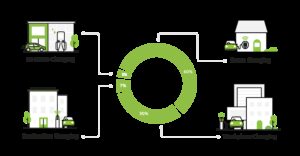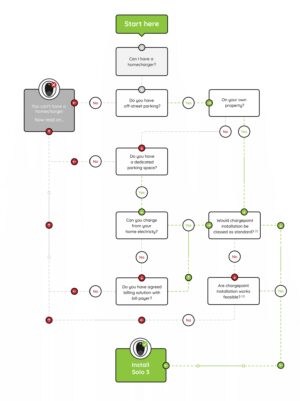How to Charge if You Can't Get a Home EV Charger
A guide that covers how you can still drive a full battery EV (BEV) even if you can’t have a home charger.
Last updated: Aug 01, 2024 • 6 min read

Summary
Sometimes it’s not possible to have a home charger installed where you park your car (eg. you don’t have off street parking). If that’s the case, it doesn’t have to be a deterrent to EV ownership. It’s still entirely possible to drive a full battery EV (BEV) by charging at other locations including:
- At work.
- At public destinations.
- At rapid chargers.
- Locations that don’t exist yet but might in the future.
The charging ecosystem
It’s most convenient to charge an electric car where it is parked anyway (which is about 95% of the time) using chargepoints installed at the locations you regularly visit.
For most people that means home, then work, then your other destinations - while those journeys beyond the range of your battery will require less frequent use of high-powered en route chargers.

Home charging is where most charging occurs because it’s so convenient. However, not everyone has suitable off street parking at home that allows them to have a home charger.

Do not write off getting an EV because you can’t get a home charger, we just need to look elsewhere in the charging ecosystem.
Workplace charging
Many people use their car to get to work and park at their workplace for a good many hours, as such workplace charging offers a huge opportunity.
With most commuters driving less than 30 miles to work and BEVs increasingly having real ranges of more than 200 miles, workplace charging makes owning a BEV easy, particularly when coupled with the use of the public network for top up, as required.
Some modal interchanges (e.g. rail station car parks) can also fulfil the Workplace role.
Tip: The government WCS grant allows businesses to reduce the cost of Workplace chargepoints by up to £14,000. If you want your employer to offer chargepoints at work, the best thing you can do is ask them to contact our team to discuss options.
Destination top-up charging
If you don’t have a regular charging spot at home or work, you can always top-up at your other destinations when you’re out and about.
Pod Point is one of the companies working hard to build the public network so that there is an easy to use chargepoint everywhere you park.
There is still a way to go until there are enough chargepoints that mean you have enough top up charging opportunities to cover all but your infrequent long journeys - but we will get there.
Tip: The public network that can sustain those with no home or work charging is likely to develop as a result of the majority of BEV drivers who can charge at home/work demanding more public charging opportunities.
Destination long-stay charging
The dwell time in some car parks is so long that it enables a substantial, or even complete charge of even the biggest batteries.
Getting access to these locations can substitute having a home or workplace charger. As discussed, modal interchanges like train stations, but also airports, can fulfil this role. Potentially some commercial car parks, that have low occupancy at times e.g. over night, may offer this facility to local drivers.
Tip: Offering car parking for long stay charging is a big commercial opportunity. Businesses can generate a return by selling the parking and ability to charge, but also by making their location a port of call at the start and end of each charge event.
For example, imagine a driver who’s been charging their EV overnight in a supermarket car park. When they return to collect it on the way to work in the morning, they may well buy their breakfast from the supermarket’s bakery.
Rapid charging with charger as destination
Driving to a high powered charger, for the purpose of putting energy into your battery is much like the refuelling model for cars with internal combustion engines.
While detouring (e.g. once a week or so) to charge at rapid chargers benefits from familiarity to the ICE driver, it is not the most appealing option; it can be quite time consuming in both the extra detour and the wait for charging (beware the Rapid Charge Paradox, i.e. “The faster the charging point, the longer you spend watching your car charge”).
If you can twin the trip with something productive this can help, but it is tricky to get the timing right and it’s not considered good etiquette to occupy the charger after you are finished charging.
Perhaps we will develop facilities at these hubs that make the dwell time productive/enjoyable (or vice versa). However, scaling rapid charging is very costly, making charging costs likely to threaten/exceed the cost of petrol for the users.
Well placed rapid chargers are critical to EV uptake, but compared to inexpensively charging when you have left your car parked while you do something else, they are not an appealing way to do the bulk of your charging.
Tip: One concept of regular rapid charge usage that feels more friendly is to top up on the rapid charger just as long as you are using a convenience facility. For example, if you stop to get a sandwich, a drink and use the facilities on the way home, on a high powered charger you may get some 50-70 miles of range with no material wait time.
But higher infrastructure costs also mean this will be an expensive way to charge.
Future gazing...
While we believe anyone can drive a BEV if they so wish, some may currently need to suffer a degree of inconvenience to do so. But it won’t stay this way forever. Aside from a significant development of the charging network, what technologies are on the way that will help?
On-street charging
To date on-street charging is a mix of a handful of very expensive to install conventional chargepoints, that add to street clutter and some sockets added to existing lamp-posts that cleverly allow users to eke out a slow, but useful charge. Neither will scale to materially enable mass adoption.
We believe it is feasible for charging infrastructure to be installed into the street environment in an unobtrusive and cost effective manner. However, such systems will require sufficient demand and utilisation, and in order to get to this point, we need to see more EVs hit the market.
Autonomous features
When you can send your car somewhere without having to drive it, those without home chargers will be able to send their cars someplace to charge, thus giving a new utility to long-stay destination parking. However, those without off street parking are likely to be amongst the first to ditch their cars, opting instead for ride-hailing very inexpensive autonomous electric vehicles (AEVs) for their vehicular mobility needs. This will further reduce the scale of the challenge.
Tip: Providing the capacity to charge the AEVs (largely overnight during fleet redundancy) will be its own challenge, and some form of inductive or smart conductive charging will need to further develop. However, should Tesla’s approach of establishing a fleet of customer-owned AEVs take hold (and it has advantages), then the AEV fleet may be democratised and much of it still charged at home and work. Time will tell!
